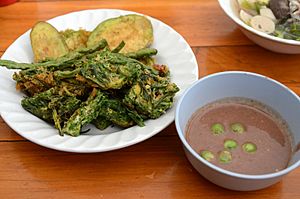Senegalia pennata facts for kids
Quick facts for kids Senegalia pennata |
|
|---|---|
 |
|
| Scientific classification | |
| Genus: |
Senegalia
|
| Species: |
pennata
|
| Synonyms | |
|
|
Senegalia pennata is a plant known by many names, like English: climbing wattle. In different parts of Asia, it's called Vietnamese: rau thối, Thai: ชะอม (cha-om), Burmese: ဆူးပုပ် (pronounced sʰúboʊʔ), Khmer: ស្អំ, khang in Meiteilon, khang-khu in Thadou-Kuki, Khangkhuh in Paite Language, khanghu in Mizo, khanghmuk in Hmar, khang-hu in Biate, and petai duri in Malay.
This plant grows naturally in South Asia and Southeast Asia. It can be a shrub or a small tropical tree, reaching up to 5 meters (about 16 feet) tall. Its leaves are special, divided into many small leaflets, making them look feathery. The leaves are smooth and shaped like long rectangles. Its yellow flowers grow in clusters at the ends of branches, looking like round balls. After flowering, it produces thin, flat, and long seed pods with thick edges.
Contents
Delicious Uses of Climbing Wattle

The young shoots of Senegalia pennata are very popular for cooking in many Asian countries. People pick them before they get tough and thorny.
Climbing Wattle in Northeast India
In Northeast India, especially in Mizoram and Manipur, climbing wattle is a key ingredient in local dishes. For example, it's used in kaang-hou, which are fried vegetables, and in a stew called eromba. People in these areas have their own names for the plant. It's called khanghmuk by the Hmar people, khang by the Meitei, and khanghu by the Mizo.
Cooking with Cha-om in Southeast Asia
In countries like Burma, Cambodia, Laos, Indonesia, and Thailand, the feathery shoots of Senegalia pennata are used in many different ways. They are added to soups, curries, omelettes, and stir-fries.
Cha-om in Thai Cuisine
In Northern Thai cooking, cha-om is sometimes eaten raw with Thai salads, like tam mamuang (a mango salad). It's also an ingredient in a special curry called kaeng khae. In Central Thailand and Isan (Northeastern Thailand), cha-om is usually boiled or fried before eating. Pieces of cha-om omelet are often found in nam phrik pla thu, a chili dip with mackerel. It's also commonly used in kaeng som, which is a sour Thai curry.
Cha-om in Vietnamese Dishes
In Vietnam, this plant is grown in the Northwest region, in places like Sơn La and Lai Châu provinces. The Thái and Khơ Mú ethnic groups grow it as a special vegetable. The leaves have a unique, strong smell. They are used in salads, especially with mountain ebony flowers. People also use them in stir-fries, with grilled fish, pork, or buffalo meat dishes.
See also
 In Spanish: Senegalia pennata para niños
In Spanish: Senegalia pennata para niños


